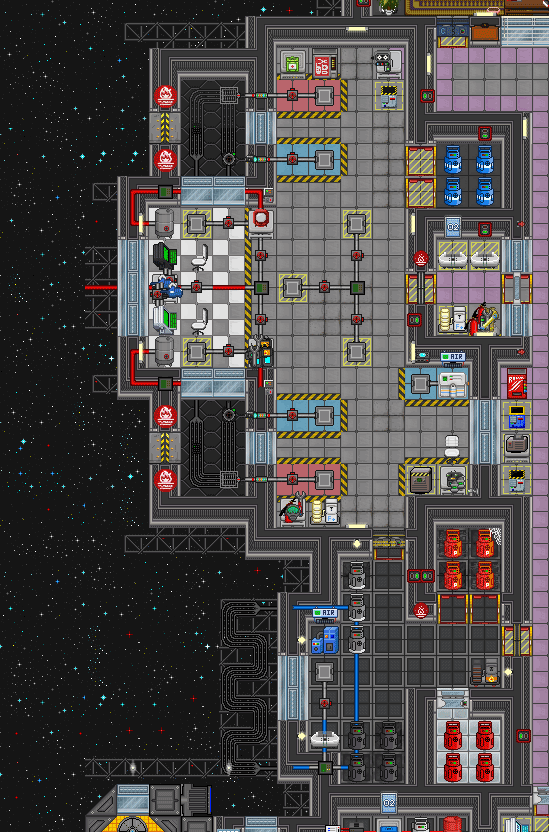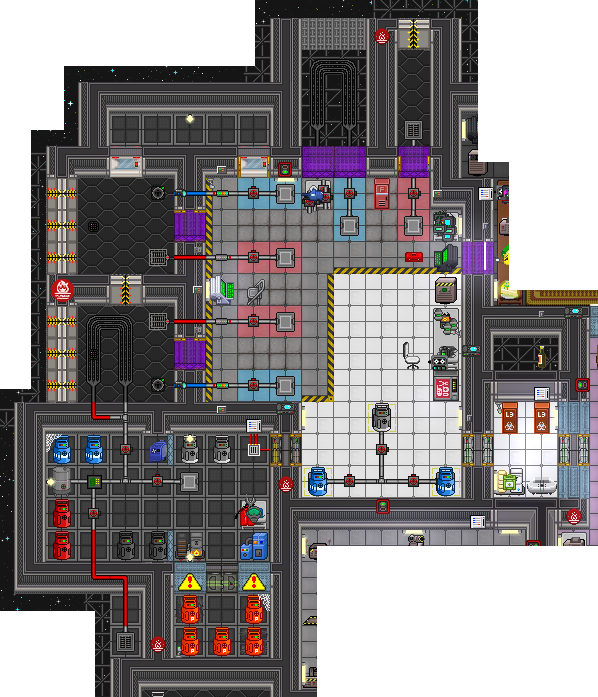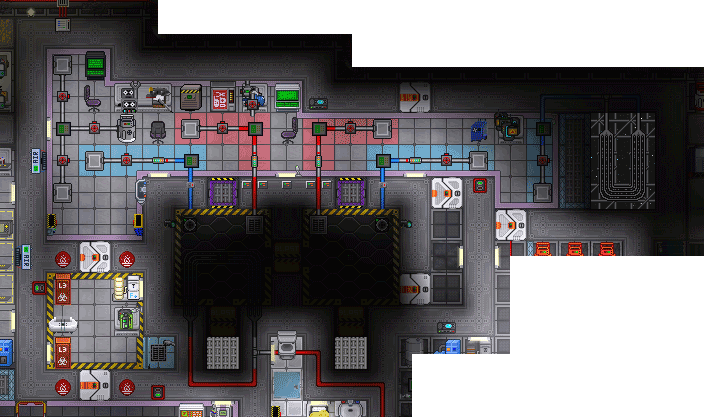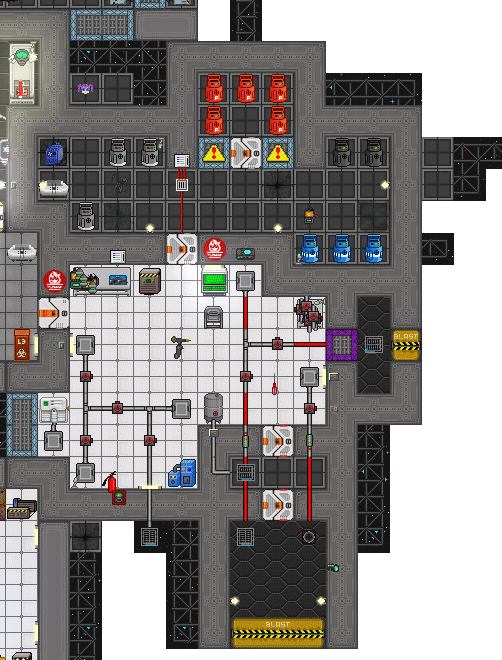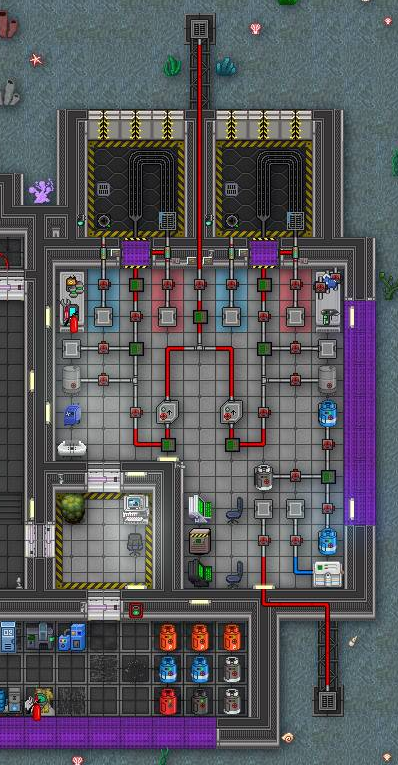User:Studenterhue/Plasma Research: Difference between revisions
Studenterhue (talk | contribs) moving toxins remake here |
Studenterhue (talk | contribs) outline some plans for the page |
||
| Line 1: | Line 1: | ||
Small rewrite of the [[Plasma Research]] that aims provide enough instructions without hand-holding or spilling secrets e.g. tell how use the burn chamber, but not what specific mix to use or how exactly long to cook | |||
Two possible approaches: | |||
-Big picture of entire toxins area with colored outlines, tabs for each map's toxins area include entire Navigating the Gasworks section | |||
--can just click on map tab and see how you cool, heat, mix, and dispose of gas on that map's toxins area--one click, that's all | |||
--while headings are visible, you cannot link to the sections in the tabs | |||
-Small pictures of relevant portions of toxins for each activity with important objects with colored outlines, tabs for each section | |||
--can link to specific sections on cooling, heating, mixing, and disposing of gas | |||
--kinda inconvenient though | |||
Plasma Research (generally known as Toxins) is where [[scientist]]s intricately study the properties and capabilities of [[Gas#Plasma|plasma]]. They do this by superheating plasma and using it to build bombs capable of ripping giant hull breaches into the station and killing everyone. Or, they might just cause an uncontrollable plasma fire in the escape arm or release super-heated carbon dioxide in the hallways, frying people from within. Generally only bad things happen in toxins, which is what makes it such a beloved part of the station. | Plasma Research (generally known as Toxins) is where [[scientist]]s intricately study the properties and capabilities of [[Gas#Plasma|plasma]]. They do this by superheating plasma and using it to build bombs capable of ripping giant hull breaches into the station and killing everyone. Or, they might just cause an uncontrollable plasma fire in the escape arm or release super-heated carbon dioxide in the hallways, frying people from within. Generally only bad things happen in toxins, which is what makes it such a beloved part of the station. | ||
<br> | <br> | ||
Latest revision as of 18:33, 14 January 2020
Small rewrite of the Plasma Research that aims provide enough instructions without hand-holding or spilling secrets e.g. tell how use the burn chamber, but not what specific mix to use or how exactly long to cook Two possible approaches: -Big picture of entire toxins area with colored outlines, tabs for each map's toxins area include entire Navigating the Gasworks section --can just click on map tab and see how you cool, heat, mix, and dispose of gas on that map's toxins area--one click, that's all --while headings are visible, you cannot link to the sections in the tabs -Small pictures of relevant portions of toxins for each activity with important objects with colored outlines, tabs for each section --can link to specific sections on cooling, heating, mixing, and disposing of gas --kinda inconvenient though
Plasma Research (generally known as Toxins) is where scientists intricately study the properties and capabilities of plasma. They do this by superheating plasma and using it to build bombs capable of ripping giant hull breaches into the station and killing everyone. Or, they might just cause an uncontrollable plasma fire in the escape arm or release super-heated carbon dioxide in the hallways, frying people from within. Generally only bad things happen in toxins, which is what makes it such a beloved part of the station.
| Don't test your bombs on the station itself unless you are a legit antagonist. |
|---|
General Practice
To connect a canister to a connector, simply drag it on top of the connector, then wrench it to connect. The gas will automatically start to flow through the pipes. The gas will proceed unless the valve is turned closed (red). The pipes into the combustion chambers are special--some are strictly outtake (gas will only flow towards the mixing room), and some are strictly intake (air will only flow out of the mixing room). More on them later.
To check out the contents of your canisters, use your scientist PDA's built in scanner on it. It will give you a summary of its total pressure, its contents by percentage, and its temperature.
Mixing
The T-shaped section of piping with three ports and valves in the rough center of the lab is for mixing gases together.
The T-shaped section of piping with three ports and valves just by the entrance is for mixing gases together.
The T-shaped section of piping with three ports and valves in the far left is for mixing gases together.
The T-shaped section of piping with three ports and valves in the middle is for mixing gases together.
The T-shaped section of piping with three ports and valves in the bottom right by the cooler is for mixing gases together.
The T-shaped section of piping with three ports and valves in the far left is for mixing gases together.
When you connect canisters to the ports and open the valves, the gases will mix together and equalize among all the containers, depending on the number of canisters and the proportions of gases. Mixing follows a consistent, somewhat sensible pattern, but it takes a while to learn.
For example, if you connect a canister of 100% oxygen and a canister of 100% plasma to two ports and open their valves, each canister will be 50% plasma and 50% oxygen. If you remove one canister and add a 100% plasma canister, the two canisters would have 75% plasma and 25% oxygen.
However, if, instead removing you then connect a canister of plasma to the third port and turn its associated valve, all three canisters would be 66% plasma and 33% oxygen. You would get a similar result if you originally had connected two canisters of plasma and one canister of oxygen and opened all their valves at the same time.
Heating
The combustion chambers is/are vacuum sealed room(s) where gas can be piped in, then ignited with a spark by pressing the igniter switch. The resulting hot mixture of gas can be pumped out of the chamber and into empty canisters through the adjacent outlet valves or used to heat whatever gases were feed into the chamber pipes. If the gas is a dud or the experimenting is finished, it can also be vented into space via the Combustion Vent switch.
Cooling
Disposal
Storage & Other
The storage room contains air scrubbers, a tank dispenser, and canisters of various types of gases, most notably, plasma and oxygen.
To test your bombs, use the special simulator equipment (for transfer valve bombs) or alternatively blow up something in the debris field.
How not to die horribly
- Always wear internals.
- Don't open any of the canisters, unless there is a tank attached.
- Do not leave any lit welders around.
- Move any welding fuel tanks out of the lab.
- Don't open a valve if you don't know what it'll do.
- If it looks like gas is leaking, use the air scrubber immediately.
